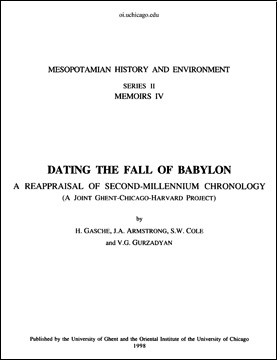Dating the Fall of Babylon: A Reappraisal of Second-Millennium Chronology

by H. Gasche, J. A. Armstrong, S. W. Cole, and V. G. Gurzadyan
This study has its genesis in a detailed examination of the pottery of Babylonia and adjacent regions in the second millennium BC. As a result of that work Armstrong, Cole, and Gurzadyan have been able to trace the evolution of Babylonian pottery and pottery technology during the second millennium. For the early second millennium, the writers can reconstruct a ceramic sequence representing the 400-year period between the fall of Ur under Ibbi-Sin and the fall of Babylon under Samsuditana. The authors also have a detailed sequence for the fourteenth and thirteenth centuries and a twelfth-to-eleventh-century sequence that, even though it is less detailed due to a lack of excavated material, is nonetheless coherent. [From Preface, p. 1, unsigned]
- Mesopotamian History and Environment Series 2, Memoirs 4
- Chicago: The Oriental Institute; Ghent: The University of Ghent, 1998
- Pp. vii + 104; 5 figures, 3 plates, 3 tables
- 8.5 x 11.0 in.
- Out of Print

